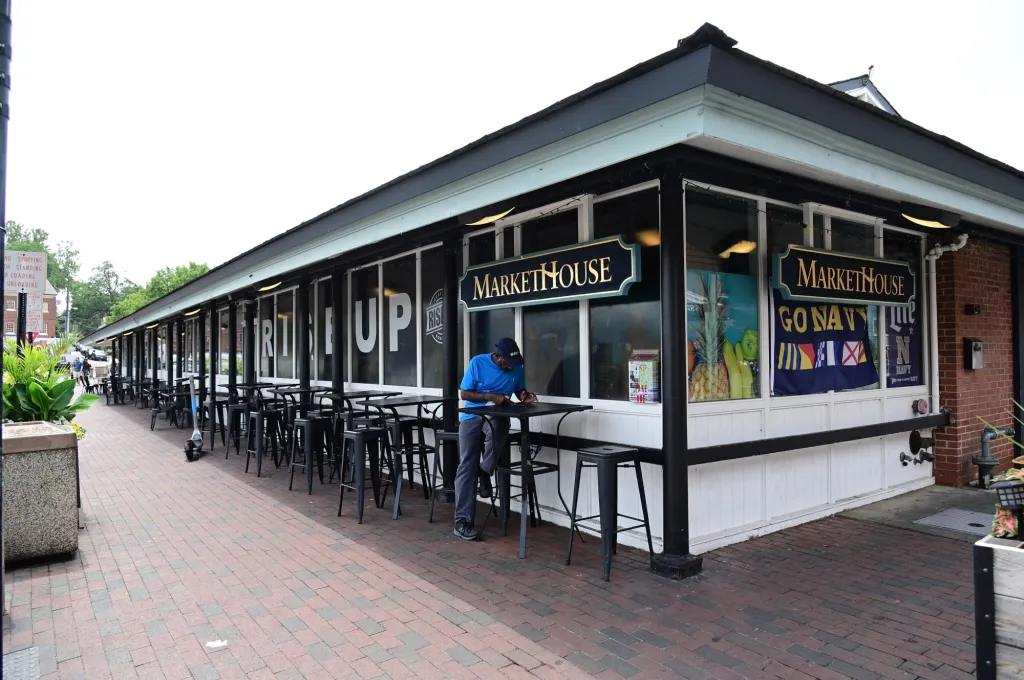Copyright Slate

Sign up for the Slatest to get the most insightful analysis, criticism, and advice out there, delivered to your inbox daily. Copper, when exposed to water and air, will slowly develop a verdigris patina on its surface, transforming its bright bronzy gleam into a tarnished teal skin. So why have the copper caps enclosing each bottle of Tito’s Handmade Vodka resisted any sign of aging at all? Because they’re made of plastic, of course. Like certain other controversial aspects of the vodka’s packaging, its iconic copper detailing is more superficial than material. Still, after 27 years in business, Austin, Texas’s homegrown booze brand is looking as polished as ever. Today, Tito’s is the most-consumed spirit in America, selling over 12 million cases (that’s about 43 Olympic-size swimming pools of corn-based vodka) for some $2.6 billion in 2024 alone. At such a production volume, though, I marvel that the label on each bottle still reads “Handmade.” This is vodka we are talking about—by definition a flavorless and colorless spirit. Producers must crank out ethyl alcohol at near-chemical levels of purity—usually around 95 percent alcohol by volume. They then water the distillate down to a potable strength—usually around 40 percent abv. At the end of the day, how handmade can that process really be? Perhaps it is the sterile anonymity of vodka’s production that accentuates the potency of a given brand’s story, which raises the question: Who is this Tito? The fortuitously named Bert “Tito” Beveridge (yes, pronounced like beverage), the now billionaire owner and founder of Tito’s producer Fifth Generation Inc., has remained the face of his eponymous brand since registering as the first post-Prohibition distiller in Texas in 1997. In a saturated spirits market, he has spent the past 25 years capitalizing on his homegrown Texan credentials to peddle a vision of copper and corn that has catapulted his brand to the forefront of America’s back bar. Even as the global spirits industry faces a downturn, Tito’s looks particularly strong. The same week in September that Diageo, the owner of the second bestselling spirit brand in America, Smirnoff, ceased production of whiskeys at two large American distilleries, Tito’s doubled down and announced the acquisition of the upstart brand Lalo Tequila. Like Tito’s, Lalo hangs its hat on a story built around clear spirits, simple ingredients, and clean flavor. The purchase made waves in the spirits industry, where acquisitions usually go to big-name multinationals like Diageo, Pernod Ricard, or Suntory Global Spirits. “Tito’s is privately held, it’s not bureaucratic, and they don’t have a huge portfolio,” explained Susan Mooney, CEO of Spirits Consulting Group. “Tito Beveridge is now who you want to acquire your brand if you are an entrepreneur. He’s going to give Lalo a huge leg up in terms of distribution.” As America’s favorite vodka moves into the big leagues of building a diversified spirits portfolio, it’s worth reconsidering the secret behind the success of what is—despite whatever associations with homespun goodness it may have cultivated in the American imagination—an industrial vodka hiding in a craft distiller’s bottle. Fifth Generation’s production facility southeast of Austin is a sprawling industrial complex corralled behind a barbed-wire fence. The entry gates have placards warning NO SMOKING (high-proof spirits are extremely flammable) and NO CAMERAS. The second of these signs leaves me with some questions. Many of the world’s most prominent spirits brands invest millions of dollars in building out distilleries and rickhouses for storing barrels during aging that not only serve functional purposes in production but also act as beautiful venues for alcohol tourism. It’s part of building a story around a brand. The story needs a convincing setting—a place of origin. These showcases range in complexity from the heritage-steeped, 60-distillery Kentucky Bourbon Trail to the three-story window at your nearby craft distillery, giving you a glimpse of the curvy copper contraption that spits out the local gin. Tito’s Handmade Vodka has done nothing of the sort. You can read all about how the mortgage lender Tito Beveridge got the idea for a distillery after making his friends vodka infused with fruits and vegetables. You can read about his legal battles with the state of Texas over the opening of a licensed distillery. You can read about how he developed his own corn vodka recipe and built his first vodka still by hand. You just can’t see it. Any of it. Remember, NO CAMERAS. Mooney contrasts Tito’s commercial success to that of the high-end vodka Grey Goose. “The whole brand stays very true to this do-it-yourself, no-frills, no-snobbiness Americana, and that’s what continues to keep people loyal to Tito’s,” she explains. “Grey Goose launched in 1997”—the same year as Tito’s—“but it’s a different approach. There’s no personality associated with it. It’s feeling very corporate.” While drinkers might not be able to visit or photograph the old-fashioned copper stills that are printed on every Tito’s label, they can see advertisements with Tito Beveridge and his beloved dog, DogJo (among other dogs in their philanthropic Vodka for Dog People program), producing America’s homegrown corn liquor. Some consumers, though, have struggled to reconcile the gap between marketing and production. Tito’s spent much of the 2010s fighting off a barrage of lawsuits targeting its decades-old claim of being “handmade.” Separate suits were filed in California, Florida, Illinois, New Jersey, and New York. Yet, in 2025, the “handmade vodka” label is still sticking. “With Tito’s, ‘handmade’ is a weird phrase,” said Michael Meyerson, a professor at the University of Baltimore School of Law, who testified as an expert witness in the 2016 New York State lawsuit Singleton v. Fifth Generation Inc. “The way they presented their product on their website and advertising—it was always small batch, handmade, hiding the fact that there was a giant factory cranking it out.” But, as Meyerson explained, only false claims that “a reasonable consumer would understand to be a verifiable fact” can be punishable in court. In the New York suit, Tito’s lawyers argued “that ‘handmade’ as used in connection with alcohol distillation is non-actionable ‘puffery.’ ” “Mere puffery,” besides being a potential name for a new Tito’s-based cocktail, is a legal term that refers to the practice of hyping up a product in a way that a reasonable consumer can easily understand is exaggerated. In other words, when Tito’s claims to be “handmade,” it’s legally akin to a random gas station claiming to serve the “world’s best cup of coffee.” They get away with it, and we are supposed to buy it without taking umbrage at the artifices of salesmanship. The experience hasn’t phased Fifth Generation, which is taking a stake in the most contentious category in spirits with its acquisition of Lalo tequila. Where Tito’s was the darling of consumer lawsuits in the 2010s, the tequila category is proving to be the hotbed of liquor labeling litigation of our current decade. Labels reading “100% Agave” are being questioned in court as deceptive or verifiably untrue (allegedly containing cane alcohol or non-agave sugars). Several suits have been filed against Diageo’s Casamigos and Don Julio, another against Michael Jordan’s Cincoro, and a third filed by tequila’s governing body, the Consejo Regulador del Tequila, against an American effort to certify tequilas as “additive free.” In September, a trade body advocating for “100% Agave” tequila filed a criminal complaint against the CRT in Mexican courts, alleging that they have knowingly permitted adulteration. It’s important to clarify that Lalo labels itself as “100 percent agave azul,” and I have no reason to doubt that this is true. Whether they read “Handmade” or “100% Agave,” liquor labels say very little else. Traditionally, spirits labeling has been exempt from the pesky nutritional and ingredient requirements of all the other foods and drinks we consume. Tito’s has benefited from the growing valorization of better-for-you products, and their marketing leans heavily on the fact that their vodka is made from corn and is thus gluten-free (all unadulterated distilled spirits are gluten free, though individuals with allergies or celiac should take precautions with cross-contamination) with certification by the Gluten Intolerance Group among the vodka’s accolades. As a category, tequila, too, has capitalized on health trends focusing on its relatively low sugar and calorie content. But it seems these distillers want to have their rum cake and drink it too. “Advertisers have a choice on how they deal with consumers who are willing to put their good money in favor of purity and clarity of good ingredients,” Meyerson said. But, as Tito’s and the tequila industry more broadly are learning, there is a fine line between pandering to health-conscious drinkers and drawing the ire of class-action lawsuits. It turns out that the same consumers willing to shell out for healthy products also want to see truthful statements on labels. The reality is that Tito’s Handmade Vodka is still flying off the shelves at a rate that human hands could never hope to produce. Around the country, a constant utterance drifts across bar tops: “Tito’s and … cranberry, soda, lemonade, tonic, vodka.” Oh yes, Tito’s and Vodka, a drink order that a surprising number of bartenders complain about receiving. Scaling a craft spirit is every distiller’s dream, but at some point, the craft—once the realm of the master distiller—becomes a process controlled by a Ph.D. in chemical engineering. A final question, then, remains: Is the finished liquor any good? Does “handmade” really matter? As Veronika Karlova, a vodka consultant and chair of judges for the World Vodka Awards (who is also affiliated with Beluga Vodka), told me: “In terms of the quality of a spirit, vodka is where it all starts. It doesn’t hide behind maturation or botanicals. With vodka, we are talking raw ingredients and water. With other spirits, even other white spirits, there are additives. It’s quite different because you can’t mask anything.” Since its inception, Tito’s has been proud of the fact that it makes its vodka from corn. When fermented and distilled, corn is an excellent source of beverage alcohol. And it’s cheap. “The U.S. is the largest producer of corn,” Karlova notes, “so it makes sense to use it. You’re making good quality vodka, sourcing it locally, and providing it to local people.” I, for one, don’t find Tito’s to be a bad vodka. But is my consumer brain a bit insulted that they call it “handmade”? Sure. Tito’s is as handmade as this article is handwritten. I used my hands to write it on a keyboard, but is that what handwritten means? Ultimately, it’s hard to pit inherently flavorless and colorless spirits against one another. In lieu of taste preference, we are left to go on the story that a brand sells to us. At $30 to $40 dollars a 1.75-liter handle, Tito’s remains an approachable middle range offering on the vodka shelf. It’s neither plastic bottle sleazy nor glazed bottle bougie. For a country that prides itself on its entrepreneurial, homegrown middle class, Tito’s seems to have captured the spirit of the times. “In Tito’s advertising you see a dog, backyard BBQs, and pool parties at someone’s house,” concludes Spirits Consulting Group’s Mooney. “I think that [kind of] Americana is playing well.”



